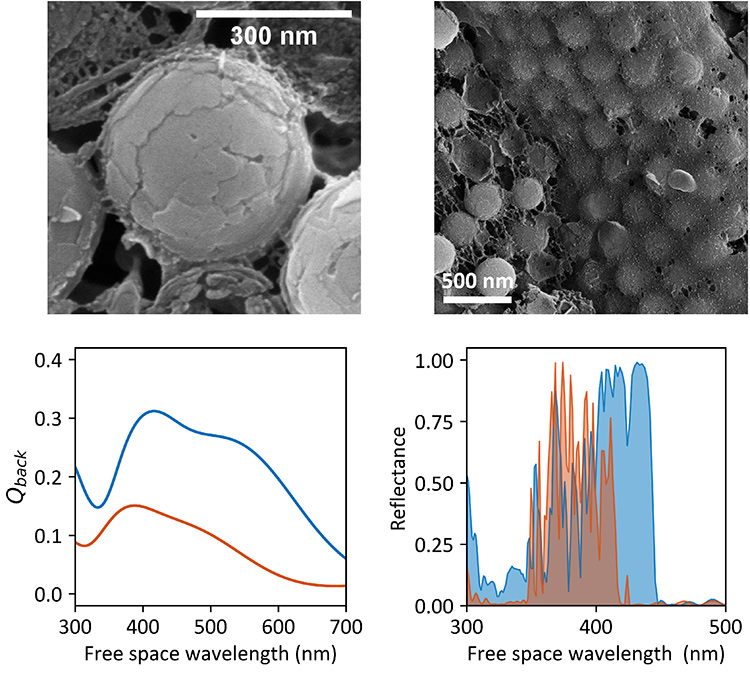 Top: Spherulitic shells made of crystalline isoxanthopterin plates (left) and densely packed assemblies of isoxanthopterin spherulites exhibiting short-range order (right). Bottom left: The backward-scattering efficiencies of a spherulite (blue) together with that of spherical shell made of an effective isotropic dielectric medium (red). Bottom right: Reflectance from a close packed assembly of spherulites (blue) exhibits a wider band and more efficient reflection than an assembly of isotropic spherical shells (red). [Figure is reproduced with permission from ref. 2]
Top: Spherulitic shells made of crystalline isoxanthopterin plates (left) and densely packed assemblies of isoxanthopterin spherulites exhibiting short-range order (right). Bottom left: The backward-scattering efficiencies of a spherulite (blue) together with that of spherical shell made of an effective isotropic dielectric medium (red). Bottom right: Reflectance from a close packed assembly of spherulites (blue) exhibits a wider band and more efficient reflection than an assembly of isotropic spherical shells (red). [Figure is reproduced with permission from ref. 2]
Photonic structures are responsible for the vivid colors of many animals, and also serve as reflectors and filters in vision. One such reflector is the tapetum, which lies behind the eye’s photoreceptors. Photons that have not been absorbed by the retina in their first pass are reflected back by the tapetum for a second chance at absorption, increasing the sensitivity of the eye.
Our recent work has revealed that in several decapod crustaceans, the tapetum consists of a dense assembly of spherical nanoparticles approximately 300 nm in diameter.1 Each sphere consists of plate-like isoxanthopterin crystals arranged concentrically, much like the layers of an onion, in a shell around an aqueous core. These crystals are birefringent, resulting in different refractive indices for different light polarizations. Within each particle, the crystal a-axes always point in the radial direction.2 Consequently, light polarized along the radial direction experiences a much smaller refractive index (1.4) than light polarized tangential to the nanoparticle surface (1.96). Such particles are called spherulites.
Curious about the role of birefringence in the performance of these reflecting structures, we calculated the backward-scattering properties of individual isoxanthopterin spherulites. We found that the birefringence results in a twofold increase in the backward-scattered intensity in the visible wavelengths, especially in the blue region of the spectrum, which is most relevant to vision in marine crustaceans.2
In a face-centered-cubic assembly of such particles, the birefringence results in a wide band of high reflectance at blue wavelengths that spans about 50 nm. The high reflectance occurs for structures as thin as a few micrometers, and results from pseudogaps in the photonic band structure in the relevant propagation directions.3 The rotational symmetry of each spherulite ensures that individual spherulite orientations do not affect the optical properties of the assembly as a whole.
Both the diameter and the shell thickness of each spherulite appear to have been optimized by evolution for the best performance as a reflector in the blue region of the spectrum. Our studies demonstrate the utility of assembling nanoscale spherulites, and motivate further research into exploiting spatial variation of birefringence in designing ultrathin reflecting photonic structures.
Researchers
Venkata Jayasurya Yallapragada, Lia Addadi, Steve Weiner and Dan Oron, Weizmann Institute of Science, Rehovot, Israel
Benjamin Palmer, Ben-Gurion University of the Negev, Beer-Sheva, Israel
References
1. B.A. Palmer et al. Proc. Natl. Acad. Sci. USA. 115, 2299 (2018).
2. B.A. Palmer et al. Nat. Nanotechnol. 15, 138 (2020).
3. V.J. Yallapragada and D. Oron, Opt. Lett. 44, 5860 (2019).
